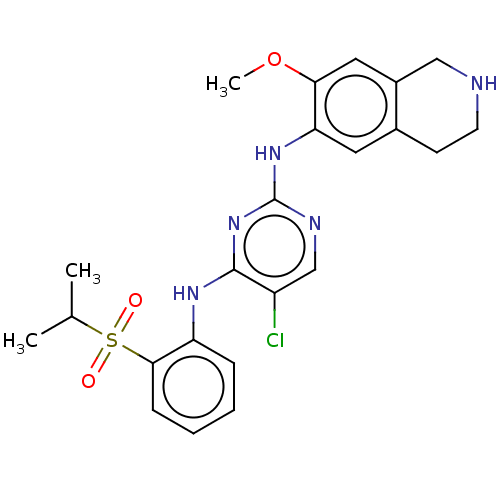BDBM243370 5-chloro-N4-(2-(isopropylsulfonyl)phenyl-N2-(7-methoxy-1,2,3,4-tetrahydroisoquinolin-6-yl)pyrimidine-2,4-diamine::US10053458, 2
SMILES COc1cc2CNCCc2cc1Nc1ncc(Cl)c(Nc2ccccc2S(=O)(=O)C(C)C)n1
InChI Key InChIKey=NEBHHPFFBCTEBR-UHFFFAOYSA-N
Data 8 IC50
Activity Spreadsheet -- Enzyme Inhibition Constant Data from BindingDB
 Found 8 hits for monomerid = 243370
Found 8 hits for monomerid = 243370
Affinity DataIC50: 1nMT: 2°CAssay Description:A proliferation inhibitory activity against the ALK of the compound represented by Chemical Formula 1 according to the present invention at an enzyme...More data for this Ligand-Target Pair
TargetALK tyrosine kinase receptor [L1196M](Human)
Korea Research Institute of Chemical Technology
US Patent
Korea Research Institute of Chemical Technology
US Patent
Affinity DataIC50: 1nMAssay Description:Inhibition of ALK (unknown origin) using peptide substrate incubated for 30 mins in presence of ATP by fluorescence assayMore data for this Ligand-Target Pair
Affinity DataIC50: 5.90nMAssay Description:Inhibition of crizotinib-resistant ALK G1202R mutant (unknown origin) using peptide substrate incubated for 30 mins in presence of ATP by fluorescenc...More data for this Ligand-Target Pair
Affinity DataIC50: 10nMAssay Description:Inhibition of crizotinib-resistant ALK L1196M mutant (unknown origin) using peptide substrate incubated for 30 mins in presence of ATP by fluorescenc...More data for this Ligand-Target Pair
Affinity DataIC50: 1.70nMAssay Description:Inhibition of crizotinib-resistant ALK G1269A mutant (unknown origin) using peptide substrate incubated for 30 mins in presence of ATP by fluorescenc...More data for this Ligand-Target Pair
Affinity DataIC50: 2.10nMAssay Description:Inhibition of crizotinib-resistant ALK F1174L mutant (unknown origin) using peptide substrate incubated for 30 mins in presence of ATP by fluorescenc...More data for this Ligand-Target Pair
Affinity DataIC50: 3nMAssay Description:Inhibition of crizotinib-resistant ALK C1156Y mutant (unknown origin) using peptide substrate incubated for 30 mins in presence of ATP by fluorescenc...More data for this Ligand-Target Pair
